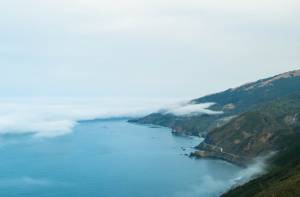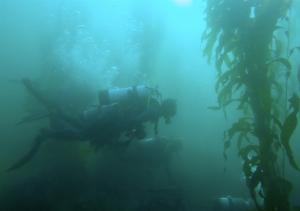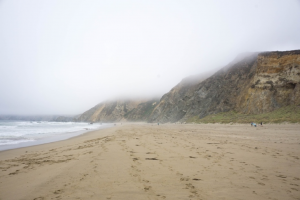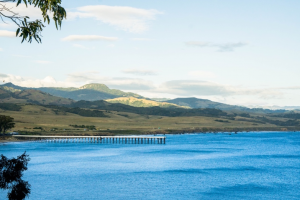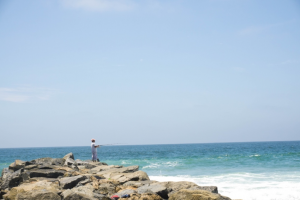Community Science: How Ordinary People Can Make an Extraordinary Difference
It is no surprise that many Californians are ocean-minded. From the rugged cliffs and wooded coastline in Northern California to the white sand beaches in San Diego, residents have access to some of the most incredible places on the planet. Stretching over 1000 miles, the California coast consists of vast beaches, long point-break waves, rocky reefs covered with sea stars and crabs, underwater kelp forests and a spectacle of marine mammals like whales, sea lions and dolphins playing in the sea. An abundance of coastal jobs including commercial fishing support local economies, while recreational activities from surfing to diving to family beach days give endless joy to beachgoers everywhere. People who are fortunate enough to spend time on this coast recognize the importance of protecting it so that future generations can relish in the same natural wonders.
However, we are now at a tipping point. Due to centuries of overexploitation of the natural world and the unsustainable use of resources, humans pose imminent threats to marine life everywhere. Rising sea temperatures, pollution from oil spills and trash, and harmful fishing practices are just a few of the problems that these treasured underwater and nearshore environments are faced with today.
While some of the top scientists in the world work in collaboration with marine conservation groups to identify the problems and find solutions, the efforts of a few pale in comparison to all of us working together. Now more than ever, it is crucial to engage communities in science-based conservation efforts. With more people involved, research can be conducted over much larger areas and over a much longer time scale.
Imagine how much more knowledge would exist if the millions of people who live on the coast were making observations, rather than just a small group of scientists. Community science is the ideal opportunity for anyone who wants to become an ocean steward by engaging in science and conservation. No required Masters or PhD degree—just the willingness to go through a little training and the desire to make a positive difference.
There are many opportunities to participate in local and statewide marine science programs. Whether you are a student, a parent, a SCUBA diver, a fisherman, surfer, part of an indigenous tribe, or simply someone who is ocean-minded and curious—there is a program for you to get involved in. Opportunities range from performing SCUBA diving surveys to simply making observations from the beach.
Corte Madera resident and volunteer, Geneva Gondak, remarked on her experience with the MPA watch program: “I am so happy to have been part of a community science program, as I believe that community science is one of the best ways to allow volunteers to support greater environmental causes in a tangible way.”
Since the information collected needs to be usable by researchers and other stakeholders, it is important for people to engage in projects with reputable organizations. These reliable programs train volunteers and ensure the accurate collection of data that can later be used by management agencies, people in academia and even local communities.
Below are some opportunities with various programs in locations that span the coast of California—from statewide programs to regional-specific organizations.
Statewide
1. MPA Watch
“Marine Protected Area (MPA) Watch is a network of programs that support healthy oceans through community science by collecting human use data in and around our protected areas.” – mpawatch.org
MPA Watch consists of multiple programs along the California coast that have volunteers observing and recording coastal activities occurring onshore and offshore in Marine Protected Areas (MPAs). Most volunteers complete surveys by foot, following specified routes and using a field manual to help guide the observations that they record. The data informs management agencies and local communities on how we use and impact the ocean (from commercial fishing to surfing) and notes where these activities occur in reference to MPAs.
MPA Watch volunteer, Lena Zentall, notes the positive experience she had bringing her son into the world of community science, “I value that he learns about the importance of community service and of protecting the environment through this first-hand experience. And sharing time in Point Reyes outdoors is our ‘happy place’!” Between 2011 and 2019, over 23,000 surveys have been collected—providing pertinent information to stakeholders that are engaged in monitoring and protecting the ecosystems within MPAs.
2. Reef Check CA
“We work with marine managers, researchers and the public to provide the scientific data needed to make informed, science-based decisions for the sustainable management and conservation of California’s ocean environment.” – Reef Check CA
Are you a diver interested in doing useful science while having fun and diving along the beautiful California Coast? Reef Check might be just the opportunity for you then. Volunteers range from avid SCUBA divers, surfer and kayakers to fishermen and regular community members. For over twenty years, Reef Check’s volunteer divers have been collecting information on California’s kelp forests and rocky reefs. The program focuses on looking at the environments inside and outside of MPAs—aiming to provide high quality data that can be used for adaptive management. Using standardized methods and protocols to ensure quality data collection, volunteers are trained to dive as Reef Check certified data collectors. It is a unique program that combines education, research and conservation—empowering people to become knowledgeable about their coastal ecosystems and give back in an exciting, hands-on way.
3. MPA Collaborative ROV Program
“Marine Protected Area (MPA) Collaborative Members statewide are field testing Trident mini-ROVs (remotely operated vehicles) from SoFar Ocean in underwater expeditions focusing on MPA outreach, compliance, and citizen science projects.” – MPA Collaborative ROV Project
Various community science projects launched by MPA collaborative organizations are using mini-ROVs to collect underwater data. Projects span from the north to south coast of California—from eelgrass monitoring in Bodega Bay and exploring the giant kelp forests of Point Lobos to monitoring marine debris in Monterey and studying the underwater ecosystem in Morro Bay. Information collected during these underwater ROV expeditions is vital for understanding the range of species, the complexity of habitats and the physical and biological processes occurring below the surface of the ocean.
4. LiMPETS
“LiMPETS monitors the biology in rocky intertidal and sandy beach ecosystems and aims to provide publicly accessible, scientifically sound, long-term data to inform marine resource management and the scientific community.”— LiMPETS.org
LiMPETS, or Long-term Monitoring Program and Experiential Training for Students, is another valuable statewide community science program that involves monitoring the coastal zones of California’s national marine sanctuaries. The program works in collaboration with school and environmental education groups and contributes valuable data on coastal changes and new threats to the environment. Data is collected by over 6,000 people annually and has been used to establish baselines and monitor future changes of key indicator species within California MPAs.
North Coast
5. Beachwatch
“A program of the Greater Farallones Association, this year-round ecosystem assessment program is conducted by dedicated volunteers who regularly survey an assigned beach within the Greater Farallones and Monterey Bay National Marine Sanctuaries.” – Beach Watch
After multiple oil spills, in 1993 researchers for the Greater Farallones Marine Sanctuary recognized the need for establishing a baseline of the marine life that lives from Sonoma to San Mateo counties, to understand how these animals are affected by such events. For over 25 years, surveyors have been collecting data on marine mammals and seabirds, as well as monitoring human activity on certain assigned beaches. The information gathered on the abundance and the location of birds and mammals has been used to guide the management of these beaches. By counting and taking photos of living and dead marine wildlife, volunteers have helped scientists and managers track the trends and impacts on wildlife from human activities.
Central Coast
6. SeaLife Stewards Morro Bay
“The program developed out of an increasing awareness of disturbance to Morro Bay wildlife, and a sense that many visitors may be unaware of wildlife sensitivity to human disturbance, both intentional and unintentional.” – http://centralcoastparks.org/wp-content/uploads/2017/01/SeaLifeStewards.pdf
Located on California’s Central Coast, Morro Bay is home to some amazing wildlife, including sea otters, harbor seals and an abundance of sea birds. But with the influx of tourists each year, the wildlife that inhabit this special estuary become subject to more human-caused disturbances. Launched in 2016, SeaLife Stewards is a program that aims to reduce these wildlife disturbances by educating visitors on proper wildlife etiquette. Every weekend from Memorial Day to Labor Day, a team of volunteers, some land-based and some circulating around the bay on kayaks and stand up paddle boards, provide eyes and ears out on the water. They engage with curious visitors by answering questions about the local environment and preventing certain activities that distress the animals. By informing people on respectful wildlife viewing, volunteers are able to minimize the physiological stress that many animals endure from human interaction. The program has been growing every year, with over 50 volunteers in the 2019 season, and data collected by volunteers shows that the program has been successful in decreasing disturbances to wildlife. SeaLife stewards is ideal for many ages, with volunteers ranging from ages 18 to 80.
7. Sea Otter Savvy
“Together we can create a ‘sea otter savvy’ community promoting responsible wildlife viewing, awareness of the effect our behavior can have on sea otters and other wildlife, and a safer, healthier coastal environment for all of us, otter and human alike.”— SeaOtterSavvy.org
Volunteers for Sea Otter Savvy are Certified Wildlife Stewards who help reduce human disturbances to sea otters. Whether from boat traffic or other recreational activities, human interactions with sea otters can put immense stress on them. Eating 25% of their body weight in food everyday, sea otters have an extremely high energy demand and must conserve energy to stay healthy. Human-caused disturbances can compromise the ability of sea otters to sustain the energy they need to forage, stay warm and take care of their pups. At Sea Otter Savvy, volunteers collect data on sea otter activity and work with the public to educate and encourage responsible viewing of sea otters—providing outreach to visitors and businesses.
South Coast
8. Gray Whale Count
“Goals of education are to teach the process of scientific research to Counters and to give them the opportunity to conduct a meaningful study, to experience marine mammals in their environment, and to share this process and their enthusiasm with publics through outreach and various media, especially the internet.” – GrayWhalesCount.org
Do you enjoy whale-watching and want to contribute to an educational research project that monitors the passage of gray whales near the Santa Barbara channel? Gray Whale count is a nonprofit organization that trains volunteers to monitor the gray whales migrating northbound. Counters become educated on the scientific process of surveying whales while getting to observe these majestic creatures in their natural environment.
Mobile Apps
9. iNaturalist- Snapshot Cal Coast
“Through this effort, together we will obtain a snapshot of biodiversity along the California coast that will be useful for scientists and managers at local, regional, and state levels.” – Snapshot Cal Coast
Another easy way to get involved in MPA conservation efforts while exploring your local beaches is by using the smartphone app, iNaturalist. Once you create an account with iNaturalist, you can join many different projects, by capturing photographs that contribute towards a compilation of community observations. Snapshot Cal Coast is a project that runs from June 1 to June 16 every year, with the goal of getting users to report the many species—both animals and seaweeds—that currently live in MPAs. By taking a photo and labeling the species, users contribute directly to a library of observations. These thousands of observations compiled by Snapshot Cal Coast enable scientists to determine the species range and abundance of many plants and animals in MPAs. Over time, researchers can track the data to monitor changes in the environment.
10. Endangered Waves App
“Empowering surfers and beach lovers to become real-time coastal stewards, and turning everyday global citizens into citizen scientists.” — Save The Waves
If you want to contribute to conservation efforts without going through a lot of formal training—you can download an app that allows you to document beaches under threat from trash, oil spills and other pollution. Save the Waves Coalition has created the Endangered Waves App for smartphone users to encourage beach goers everywhere to become advocates for coastal protection and help track marine debris. The data is shared with coastal agencies around the world, helping to prioritize the locations that are most threatened by issues such as pollution and debris and to design a plan of action.
11. Clean Swell
“With Clean Swell, simply ‘Start Collecting’ trash wherever you are around the world and the data you collect will instantaneously upload to Ocean Conservancy’s global ocean trash database. These data deliver a global snapshot of ocean trash, providing researchers and policy-makers insight to inform solutions.” – Ocean Conservancy, Clean Swell
A mobile app launched by the Ocean Conservancy, Clean Swell unifies people all around the globe who are passionate about cleaning up our beaches and finding solutions for keeping our seas clean. The app encourages people to remove trash from our beaches and tracks what items they pick up. The data collected contributes to a growing database on marine debris collected by people globally, and can be used to identify trends on where and what trash exists. The app keeps track of how much trash you pick up over time, allowing you to see the direct positive impact that individuals can have on the coastal environment. Share your stories and beach cleanups on social media to inspire more people to be part of the solution too.
Get involved and join in the marine science conservation efforts today!
In a world with almost 8 billion people, it can be easy to feel like small contributions by individuals can’t make a big difference. But in the face of a changing climate and years of unsustainable consumption, resource use and damage to the marine environment—it has never been more important for everyone to work together, explore the scope of these issues and help find solutions.



